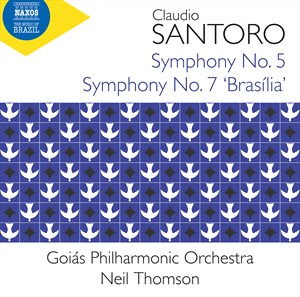

Symphony No. 5 (1955) Symphony No. 7 "Brasília" (1960)
This is Volume 8 of a new Naxos series of recordings titled "Music of Brazil", which launched in early 2019 with a recording of music by composer Alberto Nepomuceno, followed by a number of recordings featuring the music of Guarnieri and Villa-Lobos. A series that, based on Naxos' previous and ongoing collections, is sure to be extensive and comprehensive, and include many world premiere recordings.
Claudio Santoro (1919-1989) who along with famous American composers including Copland, Carter, Diamond, Harris, Glass, Piston, etc ... took the pilgrimage to Paris to study with Nadia Boulanger, composed a prolific amount of music including seven string quartets, three piano concertos and fourteen symphonies. Like all young composers of his generation, his early works seemed more in keeping with the pre-war avant-garde movement sweeping Europe at the time. But during the 1940s he opted out and decided to look for inspiration within the deep roots of his own national folk culture and traditions. But contrary to Argentinian composer Alberto Ginastera, Mexican composer Carlos Chavez or even Brazilian composer Heitor Villa-Lobos, his integration of folk elements within his music is much more subtle in its implementation.
And the booklet notes point out: "The opening movement of the Fifth Symphony is a good example of this. One of the elements most frequently used by composers of the nationalist school to incorporate a folk-based feel to their music was the Lydian-Mixolydian mode, which has an augmented fourth and minor seventh and is typically used in the traditional music of northeastern Brazil. Santoro, however, uses the same material to construct a tense, mysterious discourse, dominated by the tightly woven counterpoint in the strings, with no direct reference to folk music." Upon hearing this movement, with its dark and baleful character, you could be forgiven for assuming Claudio Santoro to be a European composer. On the other hand, the second movement which is much more lively and rhythmic in nature, and incorporates South American percussion instruments within the orchestration, would likely instill uncertainty about your assumption. All in all, this is a very strong and assured symphonic work, with a forceful outlook that leads to a powerfully unflinching conclusion.
Commissioned by Brazil's Ministry of Education and Culture to commemorate the country's construction of its new capital, the Symphony No. 7 "Brasília", at least in its highly rhythmic moments, certainly sounds more "western hemisphere" than No. 5. Within its more powerful, declamatory passages, I'm sometimes reminded of Copland's "Billy the Kid", but without the cowboy imagery of course. Its slow movement is heartfelt and passionate, as if entombing a cherished but forgotten past. South American elements once again come to the surface in the lively scherzo movement that follows, and as if he was aware of the future turmoils facing Brazil, the final movement's conflicting ideas, mysterious central passage, angular rhythms and violent outbursts, bring the symphony to an abrupt close.
This is Volume 1 of a projected complete cycle of all of Claudio Santoro's fourteen symphonies, which should prove to be a compelling survey of this composer's overlooked musical legacy.
Jean-Yves Duperron - March 2022